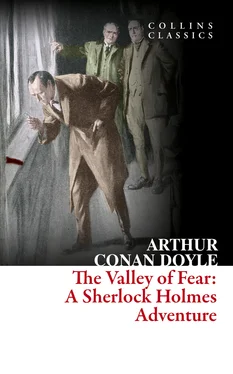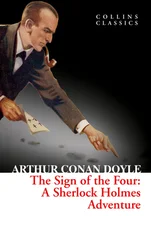Conan Doyle had invented a new literary genre by drawing on investigative and scientific developments in the world of policing in the Victorian era. The concept of collecting and interpreting evidence was coming into its own in late nineteenth-century England, and Conan Doyle saw that it offered rich potential for his story-telling. Fanciful storylines could be made convincing to the reader by the interweaving of facts, discoveries and inventions that only Holmes seemed to be privy to, thereby amazing his fellow characters and the reader alike. It was a clever device that caught the reader’s imagination and attention.
Conan Doyle’s second novel featuring Sherlock Holmes, The Sign of the Four (also known as The Sign of Four ), was published in 1890 and was the work that first introduced Holmes as a flawed eccentric to the reader. In contrast, Dr. Watson, who meets his future wife in the novel, is shown to be a far more conventional man.
Holmes is painted as a loner who is so dedicated to intellectual pursuits that he fails to make emotional connections. Yet he is not devoid of empathy, perhaps a reason why he is so devoted to solving crimes. He needs Watson by his side, since the doctor has qualities that he lacks.
The Sign of the Four demonstrated Conan Doyle’s ability to write complex yet engrossing plots, a skill that cemented his reputation as a crime novelist. It also referenced the increasingly exotic society of London in the late nineteenth century – the height of the British Empire under the reign of Queen Victoria – which lent his work a contemporary feel at the time. This is often lost on the modern reader, for whom the Sherlock Holmes stories are enjoyed as period literature.
Conan Doyle’s title is well-crafted, enticing the reader without revealing too much. The Sign of the Four indicates conspiracy and intrigue, prompting the reader to ask ‘who are the four ?’ and ‘what is meant by the sign ?’ Simply by the title alone, the author has engaged his readership before they have even begun.
The Valley of Fear is the fourth and final Sherlock Holmes novel, serialized in The Strand Magazine between September 1914 and May 1915. Some years before its publication, Arthur Conan Doyle met a man named William Pinkerton on a transatlantic voyage, and he provided the inspiration for the plot.
In the late 1870s Pinkerton was running a private investigation company in the United States, The Pinkerton National Detective Agency. The company was contracted by the government to infiltrate a rebel union, the Molly Maguires, in the Pennsylvanian anthracite coal-mining district, who were protesting about the poor conditions and wages of the mining families.
An undercover Pinkerton agent, James McParland, fed information about the Molly Maguires’ activity, which led to some of them being arrested and executed. William Pinkerton’s version of the story was that the Molly Maguires were criminals who deserved their punishment; McParland’s was that Pinkerton and the government were corrupt and had framed the Molly Maguires to keep the mine owners happy, suggesting that agents posing as the Molly Maguires had carried out various acts of sabotage – even murder – to set them up.
The Valley of Fear features arch-criminal Professor Moriarty, who was also based on a real character, Adam Worth, a German-born American. Worth was known as ‘the Napoleon of Crime’, thanks to his skill at organizing heists and moving on: New York, Liverpool, Paris, London and finally Liège, where he was eventually caught by the police in 1892. His capture was newsworthy, and excited the imagination of Conan Doyle. Holmes and Moriarty are alter egos, intellectual equals and sparring partners, yet fall on different sides of the law. Together they form the one of the best-known rivalries in literature.
PART 1
“I am inclined to think—” said I.
“I should do so,” Sherlock Holmes remarked impatiently.
I believe that I am one of the most long-suffering of mortals; but I’ll admit that I was annoyed at the sardonic interruption. “Really, Holmes,” said I severely, “you are a little trying at times.”
He was too much absorbed with his own thoughts to give any immediate answer to my remonstrance. He leaned upon his hand, with his untasted breakfast before him, and he stared at the slip of paper which he had just drawn from its envelope. Then he took the envelope itself, held it up to the light, and very carefully studied both the exterior and the flap.
“It is Porlock’s writing,” said he thoughtfully. “I can hardly doubt that it is Porlock’s writing, though I have seen it only twice before. The Greek e with the peculiar top flourish is distinctive. But if it is Porlock, then it must be something of the very first importance.”
He was speaking to himself rather than to me; but my vexation disappeared in the interest which the words awakened.
“Who then is Porlock?” I asked.
“Porlock, Watson, is a nom-de-plume, a mere identification mark; but behind it lies a shifty and evasive personality. In a former letter he frankly informed me that the name was not his own, and defied me ever to trace him among the teeming millions of this great city. Porlock is important, not for himself, but for the great man with whom he is in touch. Picture to yourself the pilot fish with the shark, the jackal with the lion—anything that is insignificant in companionship with what is formidable: not only formidable, Watson, but sinister—in the highest degree sinister. That is where he comes within my purview. You have heard me speak of Professor Moriarty?”
“The famous scientific criminal, as famous among crooks as—”
“My blushes, Watson!” Holmes murmured in a deprecating voice.
“I was about to say, as he is unknown to the public.”
“A touch! A distinct touch!” cried Holmes. “You are developing a certain unexpected vein of pawky humour, Watson, against which I must learn to guard myself. But in calling Moriarty a criminal you are uttering libel in the eyes of the law—and there lie the glory and the wonder of it! The greatest schemer of all time, the organizer of every deviltry, the controlling brain of the underworld, a brain which might have made or marred the destiny of nations—that’s the man! But so aloof is he from general suspicion, so immune from criticism, so admirable in his management and self-effacement, that for those very words that you have uttered he could hale you to a court and emerge with your year’s pension as a solatium for his wounded character. Is he not the celebrated author of The Dynamics of an Asteroid, a book which ascends to such rarefied heights of pure mathematics that it is said that there was no man in the scientific press capable of criticizing it? Is this a man to traduce? Foul-mouthed doctor and slandered professor—such would be your respective roles! That’s genius, Watson. But if I am spared by lesser men, our day will surely come.”
“May I be there to see!” I exclaimed devoutly. “But you were speaking of this man Porlock.”
“Ah, yes—the so-called Porlock is a link in the chain some little way from its great attachment. Porlock is not quite a sound link—between ourselves. He is the only flaw in that chain so far as I have been able to test it.”
“But no chain is stronger than its weakest link.”
“Exactly, my dear Watson! Hence the extreme importance of Porlock. Led on by some rudimentary aspirations towards right, and encouraged by the judicious stimulation of an occasional ten-pound note sent to him by devious methods, he has once or twice given me advance information which has been of value—that highest value which anticipates and prevents rather than avenges crime. I cannot doubt that, if we had the cipher, we should find that this communication is of the nature that I indicate.”
Читать дальше












